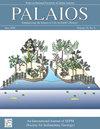LOCOMOTION TRACES EMPLACED BY MODERN STALKLESS COMATULID CRINOIDS (FEATHERSTARS)
IF 1.5
4区 地球科学
Q2 GEOLOGY
引用次数: 0
Abstract
Modern crinoids have the ability to use their arms to crawl along the sea floor and some are capable of swimming short distances. The first and only evidence of crinoid locomotion reported from the rock record was described from the Middle Jurassic of the Cabeço da Ladeira Lagerstätte (Portugal) resulting in description of the ichnotaxon Krinodromos bentou. Although the mechanics of crinoid movement are well documented the morphological ranges of crinoid motility tracks are unknown. This study uses observations of crinoid movement and their effects on sediment using modern comatulid crinoids to propose possible trace fossil morphologies. Using 20 experimental trials supported by photography, video analyses, 3D orthogrammetry and resin casting, the morphological ranges of crinoid motility tracks are included in five distinct morphologies attributed to ambling, crawling, walking, running, and landing/taking-off traces, the latter of which are emplaced before and after swimming. Traces produced by ambling occur as epigenic hook-shaped grooves. Crawling traces comprise closely spaced hook-shaped grooves and ridges preserved in concave and convex epirelief. Walking traces consist of semi-bilaterally symmetrical collections of three or more grooves, and associated ridges, preserved in convex and concave epirelief. Running traces consist of semi-bilaterally symmetrical collections of one to three straight to semi-sinusoidal grooves and associated ridges preserved in concave and convex epirelief. Landing/taking-off traces are mounded features preserved in convex epirelief, with grooves radiating from the center. The five trace types described in this paper provide insight into morphological features that can be associated with modern crinoid activities and used to identify crinoid trace fossils, which are rarely reported, in the rock record.现代无柄缨壳类动物(羽龙)留下的运动痕迹
现代的棘皮动物能够用手臂在海底爬行,有些还能短距离游泳。岩石记录中首次也是唯一一次描述了脊索动物运动的证据,是在葡萄牙卡贝索达拉德拉拉格斯塔特(Cabeço da Ladeira Lagerstätte)的中侏罗世,当时描述了脊索动物门 Krinodromos bentou。尽管有大量文件记载了棘皮动物的运动机理,但棘皮动物运动轨迹的形态范围尚不清楚。本研究通过观察现代栉水母的运动轨迹及其对沉积物的影响,提出了可能的痕量化石形态。通过摄影、视频分析、三维正射影像测量和树脂浇铸等手段进行了20次实验,将片脚类动物运动痕迹的形态范围归纳为五种不同的形态,分别是伏地、爬行、行走、奔跑和着陆/起飞痕迹,后者是在游泳前后留下的。 伏地行走留下的痕迹呈钩状凹槽。爬行痕迹由紧密间隔的钩状凹槽和脊组成,以凹凸外凸的形式保存。行走痕迹由三个或更多凹槽和相关的脊组成的半双边对称的集合体,保存在凸面和凹面的外浮雕中。 奔跑痕迹是由一到三条直线或半正弦曲线凹槽和相关的脊组成的半双边对称集合,保存在凹面和凸面的浮雕中。着陆/起飞痕迹是保存在凸面浮雕中的丘状特征,凹槽从中心辐射开来。本文所描述的五种痕迹类型有助于深入了解与现代棘皮动物活动相关的形态特征,并可用于识别岩石记录中极少报道的棘皮动物痕迹化石。
本文章由计算机程序翻译,如有差异,请以英文原文为准。
求助全文
约1分钟内获得全文
求助全文
来源期刊

Palaios
地学-地质学
CiteScore
2.80
自引率
12.50%
发文量
40
审稿时长
6 months
期刊介绍:
PALAIOS is a monthly journal, founded in 1986, dedicated to emphasizing the impact of life on Earth''s history as recorded in the paleontological and sedimentological records. PALAIOS disseminates information to an international spectrum of geologists and biologists interested in a broad range of topics, including, but not limited to, biogeochemistry, ichnology, paleoclimatology, paleoecology, paleoceanography, sedimentology, stratigraphy, geomicrobiology, paleobiogeochemistry, and astrobiology.
PALAIOS publishes original papers that emphasize using paleontology to answer important geological and biological questions that further our understanding of Earth history. Accordingly, manuscripts whose subject matter and conclusions have broader geologic implications are much more likely to be selected for publication. Given that the purpose of PALAIOS is to generate enthusiasm for paleontology among a broad spectrum of readers, the editors request the following: titles that generate immediate interest; abstracts that emphasize important conclusions; illustrations of professional caliber used in place of words; and lively, yet scholarly, text.
 求助内容:
求助内容: 应助结果提醒方式:
应助结果提醒方式:


